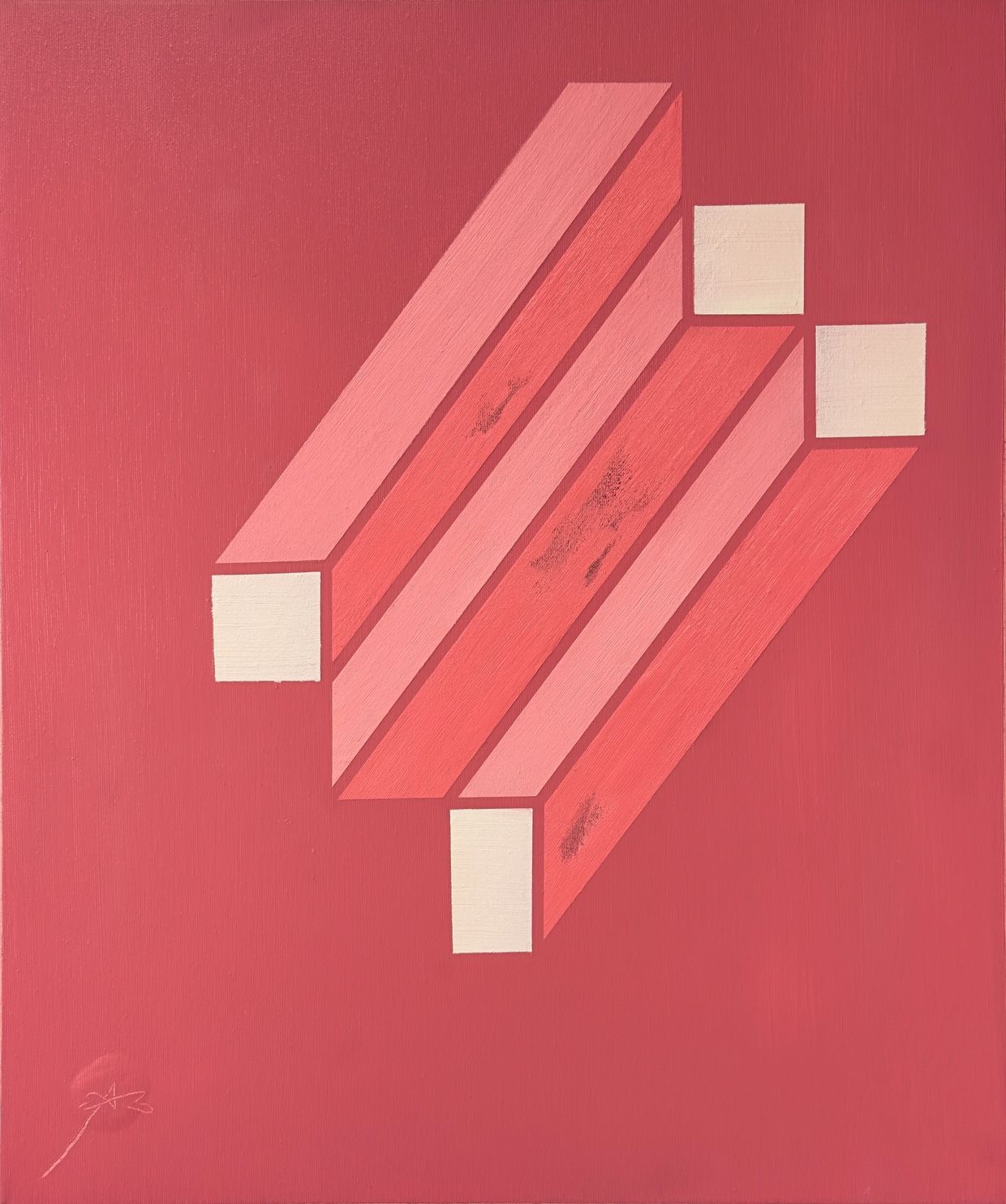
Non-Congruent Triparallels
Tibor Babos
Parallels Collection
Paradox Constructivism / Constructive Unrealism
2023
60 x 50 cm (23.6 x 19.6 in)
Oil on 3D+ Canvas
Budapest
In Private Collection
With Non-Congruent Triparallels (2023), Tibor Babos confronts the viewer with a visual theorem: what appears structured, aligned, and mathematically harmonious is in fact delicately unraveled from within. As a cornerstone of his Parallelscollection, this painting investigates the very nature of geometric order, challenging the viewer’s assumptions about congruence, equilibrium, and the possibility of truth in visual systems. It is a work that performs contradiction rather than depicts it—where certainty is only a surface and perception is its first deception.
At first glance, three identical geometric forms appear suspended in formation—rigid, minimal, and parallel. Yet their congruence begins to falter upon closer inspection. One prism subtly warps, another drifts out of alignment, and the composition fractures along the seam of expectation. The title names this tension outright: “Triparallels” suggests unyielding geometric repetition, while “Non-Congruent” denies it. Babos uses this linguistic contradiction as a conceptual blueprint. What follows is a visual dialogue between the assumed and the actual, the ideal and the imprecise. The painting invites contemplation of a larger philosophical question: can order exist without error, or is error itself the most honest form of order?
The work’s visual impact lies in its sharp restraint. Three elongated prisms stretch diagonally across a red field, each one rendered in subtly shifting shades of rose and coral. Their chromatic harmony is betrayed by moments of rupture—dark underpainted marks that rise to the surface like bruises beneath the skin. These imperfections are not mistakes but deliberate insertions of doubt, reminders that no system—geometric or ideological—can remain unfractured. The pale faces of each prism, rendered in off-white, further emphasize this fragility. They are the end points of tension: the moment where structure meets its limit.
The painting’s background is no mere void. Babos builds the red field through successive layers of oil atop a base of white gesso and black underpainting. The effect is both velvety and radiant, with occasional breakthroughs of darkness that disrupt the illusion of color purity. This chromatic instability echoes the conceptual instability of the composition—what seems whole is always on the verge of revealing its substrate. The three-dimensionality of the prisms is further heightened by the 3D+ canvas, which captures ambient light and enhances the illusion that these forms are both painted and architecturally embedded.
Perspective is studiously avoided. The prisms float without anchor—no vanishing point, no cast shadows, no spatial cues to situate them. Their diagonal rise from lower left to upper right subtly mirrors the golden ratio, an embedded reference to classical ideals of harmony. And yet Babos does not grant the viewer the satisfaction of classical resolution. The geometry is too precise to be accidental, yet too flawed to be ideal. This is not a failure of form but its deliberate destabilization. In Babos’s universe, geometry is not a tool of control but a mirror of human fallibility.
The brushwork is another locus of contradiction. Each plane is executed with such precision that the forms almost appear digitally rendered. But Babos’s hand is still present—in the minute variations of hue, in the streaks of exposed underlayer, in the textural inconsistencies that resist the sterility of machine logic. These human traces remind us that perfection is always a myth performed at the surface.
Within Babos’s broader oeuvre, Non-Congruent Triparallels plays a critical role in evolving the principles of Constructive Unrealism. If previous works sought to build impossible objects, this one goes further by sabotaging even the premise of similarity. The parallel becomes a metaphor not for repetition but for distortion—a commentary on how systems, once established, inevitably diverge from themselves. In this sense, Babos’s contribution is ontological. He does not merely depict objects; he questions the terms by which objects are known and named.
Symbolically, the piece invokes the architecture of thought itself. The prisms resemble pillars, beams, or building blocks—structures of reason. But their incongruence reveals a deeper message: even our foundations are unstable. The soft, warm palette—so unusual for such a formally rigid painting—adds emotional complexity. The reds and pinks are not cold or clinical; they are vulnerable, flesh-like, alive. The tension between their beauty and the underlying dissonance makes the piece both formally elegant and psychologically charged.
From a curatorial standpoint, this painting invites placement alongside works that explore the failure of systems, the poetry of rupture, or the geometry of thought. Its minimal palette and formal economy make it ideal for a controlled environment—preferably with raking light that reveals its surface subtleties and spatial illusions. Whether viewed as part of a conceptual series or in isolation, Non-Congruent Triparallels offers a contemplative depth that rewards both the philosophical eye and the aesthete’s gaze.
In the end, Babos does not ask the viewer to resolve the contradiction. He invites us to inhabit it. The work is a testament to paradox itself: congruent in structure, non-congruent in meaning; simple in form, infinite in implication. It is both an object and a proposition—one that confirms Tibor Babos’s position as a radical cartographer of perception in an age that craves clarity but lives within contradiction.
The Geminimal Collection
A fusion of Gemini’s duality and minimalist clarity, Geminimal explores the beauty and instability of opposites in motion. Through mirrored forms and refined abstraction, Babos examines balance, polarity, and the elusive possibility of synthesis in a divided world.
CONSTRUCTIVE UNREALISM
Budapest / New York / Miami
Copyright © 2025 CONSTRUCTIVE UNREALISM
All Rights Reserved.
This website uses cookies.
We use cookies to analyze website traffic and optimize your website experience. By accepting our use of cookies, your data will be aggregated with all other user data.
